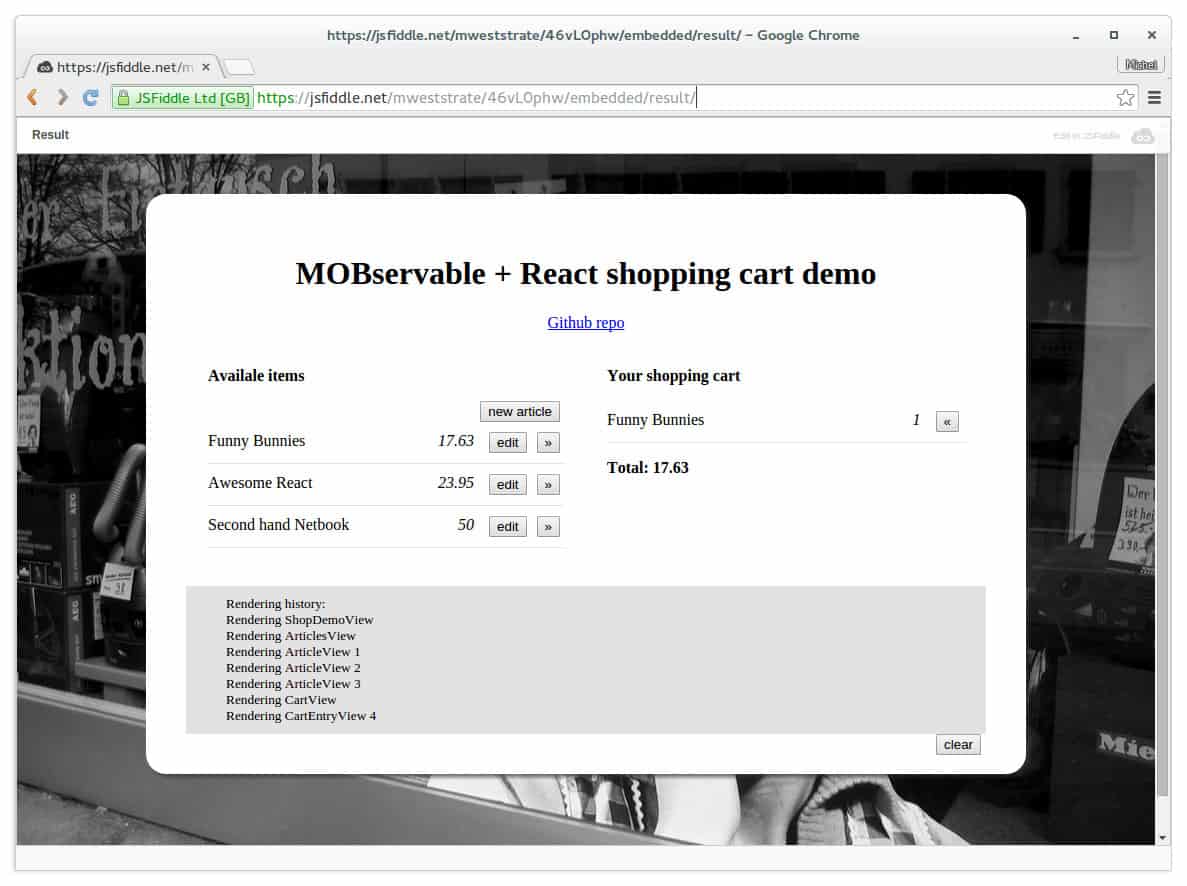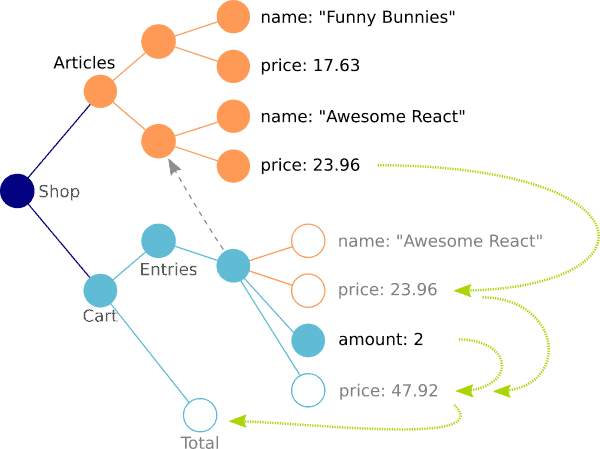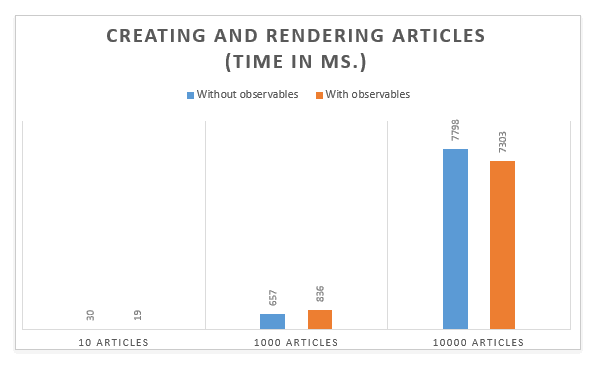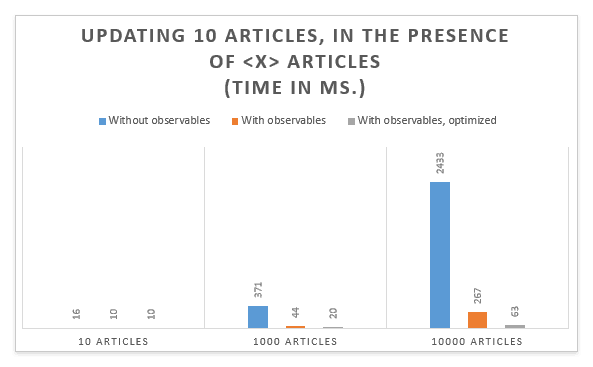Edit 2-3-2016: Mobservable has been rebranded to MobX
How do you build blazing fast react apps? Recently, we started using React in one of our large scale projects and it has helped us big time thanks to its structured way of building components and its fast virtual DOM that saves tons of UI updates. The beauty of this project is that it has quite some nice challenges; it needs to draw thousands of objects in the browser and these objects are highly coupled to each other. Values of one object might be used in an arbitrarily amount of other objects so small changes might require updates in many unrelated parts of the UI. These values might be updated by drag and drop actions of the user, so to keep the UI responsive, all updates and repaints have to happen in less than 40 milliseconds. And although plain React is fast, it didn’t take us too long to figure out that React alone wouldn’t do the job.
So we started searching for a solution that would offer us the needed performance and still allow our code base to be maintainable according to React principles. In short, we wanted an elegant solution. So we tried to leverage a concept from the world of Functional Reactive Programming; namely Observables. The selling point of observables is all computations automatically detect which other observables they use. The computation will then be re-evaluated automatically when one of these observables changes in the future. Observables are a concept used in other UI frameworks, such as Ember and Knockout. We figured out that if all our model objects became Observables and all our React components became Observers of the model, we wouldn’t need to apply any further magic to make sure the relevant part, and only the relevant part, of our UI gets updated. Read on to see all the awesomeness revealed. There are even numbers near the end!
Let’s start with a contrived example to make this a lot less theoretical (or less fussy if you prefer). Imagine a react app that represents a small shop. There are some articles, and there is a shopping cart in which you can put some of these articles. Something like this:

Poof, there it is in real life.
The data model
For starters, lets define the data model. There are articles with a name and price and there is a shopping cart with a total cost, which is based on the sum of its entries. Each entry refers to an article, stores an amount and has a derived price. The relations within our data model are visualized below. Open bullets represent the derived data that should be updated if some other data changes and so should its representation in the UI. So even in this simple model a lot of data is flowing around, and a lot of UI updates are required when stuff changes.

Lets compile a list of requirements:
- If the price of an article changes, all related shopping cart entries should re-evaluate their price.
- .. and so should the total costs of the cart.
- If the amount of articles in the cart changes, the total costs should be updated.
- If an article is renamed then its view should be updated
- If an article is renamed then the view of related cart entries should be updated
- If a new article is added tot the cart..
- etc.. etc..
Probably by now the gist of our UI problems is clear. As a programmer, you don’t want to write boiler-plate code to process all kinds of possible updates, but your user might have to wait inconveniently long if your application is always re-rendered upon each data change.
So, lets solve this problem once and for all and write down our data model:
Ok, that wasn’t too hard, right? The above constructor functions rely heavily on the MobX library, which provides a stand-alone implementation of the observable concept (it should combine with other javascript based libraries just as easy as with React). The props function creates new, observable properties on the target object, based on the provided keys and the types of the values. Due to the observable nature of all properties, the above functions are automatically (and only) updated when some of its dependencies change. This immediately fulfills some of our requirements, as, for example, the total of the cart is automatically updated when new entries are added, when the price of articles changes, etc.
The user interface
Seeing is believing, so let’s build an user interface around this model. We create some React components that render our initial data. The following JSX snippet shows a view on the shopping cart, renders all entries in the cart and shows the total price of the cart. As you can imagine, other components in the app, like the view on articles, are very similar.
Pretty straight forward, right? A CartView component receives a cart, renders its total and its individual items using the CartEntryView, which in turn prints the name of the related article and the amount of articles desired. According to React best practices, each listed item should be uniquely identifiable, so we assign an arbitrary yet immutable ID to each entry. The remove button drops this amount by one and if it hits zero the entire entry is removed from the cart. Note that nowhere in the removeArticle function did we indicate that the UI should be updated.
The next big step is forcing those components to stay up to date with the data model, for example when the entry is removed. As you can determine easily from the rendering code, there are a lot of possible data transitions; the amount of articles can change, the total cart costs can change, the name of an article can change, even the reference between entry and article can change. How are we going to listen to all these changes?
Well, that is pretty straight forward. Just use mobxReact.observer from the mobx-react package to each component and that is enough to settle all our other requirements:
Wait, what, that’s all? Yup, just check out the demo and the source of the above at JSfiddle. So what happened here? The observer function did two things for us. First, it turned the render function of the component into an observable function. Secondly, the component itself was registered as observer of that function, so that each time the rendering becomes stale a re-rendering is forced. So this function (and decorator if using ES6) makes sure that whenever observable data is changed, only the relevant parts of the UI are updated. Just play around in the example app, and while doing that, keep an eye on the log panel and see how the UI is updated based on your actual actions and the actual data:
- try to rename an article that is not in the shopping cart
- add an article to the cart, then rename it
- add an article to the cart, and update its price
- remove it from the cart, update its price again
- … etc. You will notice that with each action, the minimum amount of components will be re-rendered.
Finally, since each component tracks its own dependencies, there is usually no need to explicitly re-render the children of a component. For example, if the total of the shopping cart is re-rendered, there is no need to re-render the entries as well. React’s own PureRenderMixin makes sure that that doesn’t happen.
The numbers
So what did we achieve? For comparison purposes, here you can find the exact same app but without observables and a naive ‘re-render-all-the-things’ approach. With only a few articles you won’t notice any difference, but once the number of articles is ramped up, the difference in performance becomes really significant.


Creating large amounts of data and components behaves very similar with and without observables. But once data is changed, the observables really start to shine. Updating 10 articles in a collection of 10,000 items is approximately ten times faster! 2.5 seconds dropped to 250 milliseconds. That is the difference between a lagging and a non-lagging experience. Where does this difference come from? Let’s first take a look at the React render reports after running the updates in the “update 10 articles in a list of 10000 articles” scenario without observables:

As you can see, all twenty thousand ArticleViews and CartEntryViews are re-rendered. However, according to react 2,145 of the total of 2,433 milliseconds of rendering time were wasted. Wasted means: time that was spent on executing render functions that did not actually result in an update of the real DOM. This strongly suggests that naively re-rendering everything is a big waste of CPU time if there are many components. For comparison, here is the report of the same scenario when observables are used:

That is a big difference! Instead of re-rendering 20,006 components, only 31 components are re-rendered. And more importantly, there is no waste reported! That means that each and every re-rendered component actually changed something in the DOM. That is exactly what we intended to achieve by using observables!
From the report, it becomes clear that most of the remaining rendering time, 243 of the total 267 milliseconds, is spend in rendering the CartView, which is re-rendered just to refresh the total costs of the cart. However re-rendering the CartView also implies that all ten thousand entries are revisited to see if any of the arguments to the CartEntryViews did change. So by simple putting the total of the CartView in its own component, CartTotalView, the whole rendering of the CartView can be skipped if just the total costs changes. This drops our rendering time even further to roughly 60 milliseconds (see the ‘optimized’ series in the chart above). Thats roughly 40 times faster than the same update in our vanilla React app!
Conclusion
By using observables we built an application that is an order of magnitude faster than the same app that naively re-renders all components. And, as important (for you as a programmer), we did this without compromising the maintainability of the code. Just take a look at the source code of the two JSFiddles linked above; the two listings are very similar and are both equally convenient to work with.
Could we have achieved the same with other techniques? Maybe. For instance, there is ImmutableJS, which also makes the React rendering very fast by only updating components that receive changed data. However, you have to do much larger concession on your data model. After all, IMHO, mutable classes are in the end a tad more convenient to work with than their immutable counterparts. Besides, the immutable data structures do not help you to keep your calculated values up to date. So with immutable data, changing the name of an article would really fast re-render the ArticleView, but still not invalidate any existing CartEntryViews that refers to the same article.
Another technique one can apply to optimize a React app is to create events for each possible mutation in the data and (un)register listeners for those events at the proper moments in time and in the proper components. But this results in tons of boiler-plate code which is error-prone to maintain. Besides, I think I’m just too lazy to do such things.
By the way, I strongly advise using controllers or action dispatchers as an abstraction around updating your model data to keep the separation of concerns clear in your project.
To conclude, in large projects combining React with Observables worked so well that sometimes I saw data mutations correctly updating the UI in corner cases I did not even think of yet, without hitting any performance issues. So for me, I’ll leave the hard work of figuring out when and how to update the UI as fast as possible to React and Observables, and focus on the interesting parts of coding :).
Discuss this post on Hacker News.

